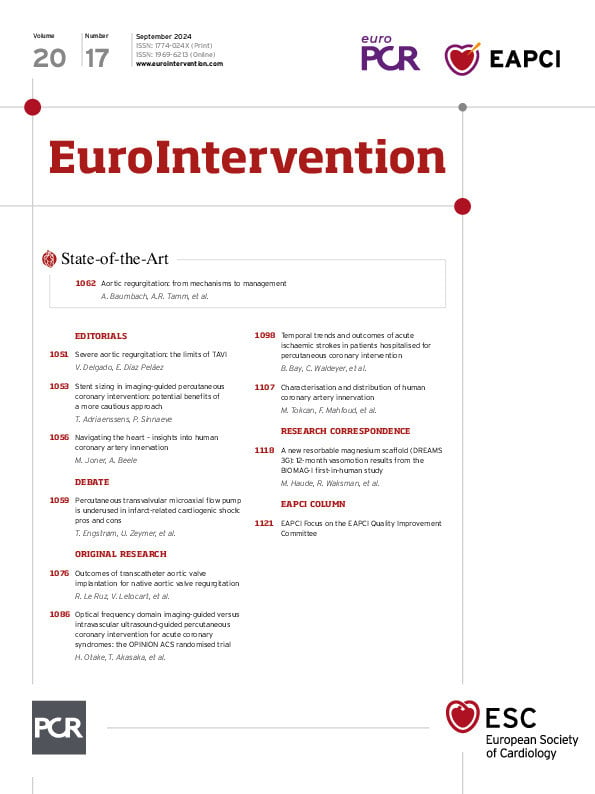Transcatheter aortic valve implantation (TAVI) is a well-established treatment for symptomatic severe aortic stenosis, but its use in native aortic regurgitation (AR) still presents challenges. Patients with native severe AR frequently have a bicuspid aortic valve, large dimensions of the aortic annulus (frequently exceeding the nominal sizes of the available transcatheter heart valves [THV]) and a low aortic valve calcification load. These aortic valve features increase the risk of significant paravalvular regurgitation and prosthesis migration, which frequently needs conversion to surgical valve replacement. In addition, patients with severe AR often have various grades of aortic root dilatation with an indication for intervention. Symptoms, left ventricular dysfunction and the need for aortic root replacement are the main determinants for decision-making in patients with native severe AR. However, there is still a significant proportion of patients with native severe AR that remains untreated (up to 53%), and the observed mortality at 2 years is almost 21%1. Although the reasons for no intervention remain underexplored, older age, associated comorbidities and high operative risk may play an important role in decision-making.
TAVI using THV dedicated to aortic stenosis has been shown to be a feasible alternative for patients with native severe AR who are deemed inoperable2. In addition, new iterations of THV designed for aortic stenosis and novel devices designed specifically for AR have provided new data on the safety and efficacy of TAVI in native severe AR3456.
In this issue of EuroIntervention, Le Ruz et al present the results of 227 patients with moderate and severe native AR who underwent TAVI with the latest generation of THV designed for aortic stenosis3. The median age was 81 years and there was a significant frequency of comorbidities such as atrial fibrillation (46.3%), chronic kidney disease (51.6%) and severe pulmonary hypertension (14.9%). The median aortic annulus diameter was 26 mm, the aortic sinotubular junction was slightly dilated (median diameter 33 mm, interquartile range 30-38 mm) and the aortic valve calcium load was low (median calcium score 95, interquartile range 0-508 Agatston units [AU]). The proportion of patients with bicuspid aortic valve anatomy was not reported. The primary safety endpoint (technical success) was achieved in 85.5% of patients, including a periprocedural mortality of 0.9% and 3.1% conversion to surgery within the same day. The frequency of at least moderate residual AR was 1.2%, and a second valve implantation was needed in 8.8% of patients.
How these results compare to previous series using new-generation THV and the registries using dedicated THV for native AR is an important question (Table 1)3456. The patients in the FRANCE-TAVI registry were the oldest and the proportion of male patients was higher compared to the other series. Although data on aortic annulus area measured with computed tomography were not provided, the proportion of THV size ≥29 mm was 74%, which suggests that the aortic annuli were large. In contrast, the patients in the ALIGN-AR trial had the smallest aortic annulus areas, probably in relation to the high proportion of female patients included6. Still, the proportion of patients receiving the largest THV (≥27 mm) was 58%, suggesting that the majority of the patients had an annulus diameter between 25.5 mm and 28.6 mm. Furthermore, the registries using new-generation THV had lower technical success as compared to the registries using dedicated AR THV, and higher rates of valve embolisation, significant residual AR, and need for second valve implantation. These differences indicate that despite using large prosthesis sizes, dedicated AR THV still perform better when the population is selected according to strict anatomical criteria.
Finally, it is important to highlight the clinical outcomes reported by Le Ruz et al3 which include 8.4% mortality at 30 days and 24% at 1 year. Although these metrics seem acceptable considering the high risk of the patients, the observed mortality is higher than that predicted by the European System for Cardiac Operative Risk Evaluation (EuroSCORE) II, and the 1-year mortality exceeds that observed in retrospective series of patients with severe AR that had been left untreated1. These data are important to feed into international clinical practice guidelines and to increase awareness on the risks and benefits of treating or not treating severe native AR.
Conflict of interest statement
V. Delgado received speaker fees from Abbott, Edwards Lifesciences, GE HealthCare, JenaValve, Novartis, Medtronic, Products&Features, and Philips; consulting fees from Edwards Lifesciences, Merck & Co and Novo Nordisk; and institutional research contracts with Philips. E. Díaz Peláez does not have any conflicts of interest to disclose.

